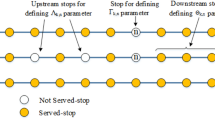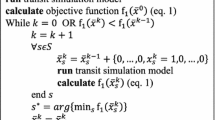Abstract
This study provides a methodology to incorporate the dynamic bus stop simulation into a proposed static transit assignment model. It tries to combine the merits of the realism of dynamic models and the simplicity of static models in a single framework. An algorithm is developed to simulate any load profile of both passenger and bus arrivals. Then, the simulation results are used within the transit assignment process to allow a better line choice representation. A detailed illustrative example is given to validate the proposed assignment methodology performance. The resulted flows in some cases exceed lines capacity while conserving the static equilibrium principles. This capacity violation interprets the fact that some passengers may fail to board the first incoming bus of their desired line due to insufficient capacity. However, they wait until a vacant space is offered on the same line. In addition, a benchmark problem is solved to ease the comparison between the proposed methodology and the existing methodologies. It shows the methodology capability of incorporating different waiting time models to produce passengers’ flow on transit lines. It also indicates the importance of lines that might be neglected in other transit assignment models. This would highlight the methodology interpretation of passengers’ behavior in transit networks.











Similar content being viewed by others
References
Ceder A, Wilson NHM (1986) Bus network design. Transp Res 20B:331–344
Ceder A (2001) Public transport scheduling. Handbooks in transport—handbook 3: transport systems and traffic control. Elsevier Ltd, Oxford
Ceder A (2002) Urban transit scheduling: framework, review, and examples. ASCE J Urban Plan Dev 128:225–244
Ceder A (2007) Public transit planning and operation. Elsevier Ltd, Oxford
Ceder A, Israeli Y (2007) User and operator perspectives in transit network design. J Transp Res Board 1623:3–7
Owais M, Osman MK, Moussa G (2016) Multi-objective transit route network design as set covering problem. IEEE Trans Intell Transp Syst 17:670–679
Szeto WY, Wu Y (2011) A simultaneous bus route design and frequency setting problem for Tin Shui Wai, Hong Kong. Eur J Oper Res 209:141–155
Owais M (2015) Issues related to transit network design problem. Int J Comput Appl 120:40–45
Ibeas A, dell’Olio L, Alonso B, Sainz O (2010) Optimizing bus stop spacing in urban areas. Transp Res Part E 46:446–458
dell’Olio L, Moura JL, Ibeas A (2006) Bi-level mathematical programming model for locating bus stops and optimizing frequencies. Transp Res Rec J Transp Res Board 1971:23–31
dell’Olio L, Ibeas A, Díaz FR (20087)Assigning vehicles types to a bus transit network. TRB 2009 annual meeting CD-ROM
Qi H, Wang DH, Bie Y (2015) Spatial development of urban road network traffic gridlock. Int J Civ Eng 13:388–399
Bosurgi G, Bongiorno N, Pellegrino O (2016) A nonlinear model to predict drivers’ track paths along a curve. Int J Civ Eng 14:271. doi:10.1007/s40999-016-0034-1
Chriqui C, Robillard P (1975) Common bus lines. Hautes Eludes Commercials Montréal Québec Canada Transportation 9:115–121
Spiess H (1983) On optimal route choice strategies in transit networks. Publication 285, Centre de Recherche sur les Transports, Université de Montréal
Desaulniers G, Hickman M (2007) Handbook in OR & MS, Chapter 2. Elsevier, Oxford
Nuzzolo A, Russo F, Crisalli U (2001) A doubly dynamic schedule-based assignment model for transit networks. Transp Sci 35:268–285
Tong C, Wong S (1998) A stochastic transit assignment model using a dynamic schedule-based network. Transp Res Part B Methodol 33:107–121
Abdelghany K, Mahmassani H (2001) Dynamic trip assignment-simulation model for intermodal transportation networks. Transp Res Rec J Transp Res Board (1771):52–60
Sumalee A, Tan Z, Lam WH (2009) Dynamic stochastic transit assignment with explicit seat allocation model. Transp Res Part B Methodol 43:895–912
Yuqing Z, Lam WH, Sumalee A (2009) Dynamic transit assignment model for congested transit networks with uncertainties. Transportation research board 88th annual meeting
Hamdouch Y, Ho H, Sumalee A, Wang G (2011) Schedule-based transit assignment model with vehicle capacity and seat availability. Transp Res Part B Methodol 45:1805–1830
Nuzzolo A, Crisalli U, Rosati L (2012) A schedule-based assignment model with explicit capacity constraints for congested transit networks. Transp Res Part C Emerg Technol 20:16–33
Hamdouch Y, Szeto W, Jiang Y (2014) A new schedule-based transit assignment model with travel strategies and supply uncertainties. Transp Res Part B Methodol 67:35–67
Speiss H, Florian M (1989) Optimal strategies: a new assignment model for transit networks. Transp Res Part B 23:83–102
De Cea J, Fernández E (1993) Transit assignment for congested public transport system: an equilibrium model. Transp Sci 27(2):133–147
Lam WH-K, Gao Z, Chan K, Yang H (1999) A stochastic user equilibrium assignment model for congested transit networks. Transp Res Part B Methodol 33:351–368
Nielsen OA (2000) A stochastic transit assignment model considering differences in passengers utility functions. Transp Res Part B Methodol 34:377–402
Lam WH, Zhou J, Sheng Z-H (2002) A capacity restraint transit assignment with elastic line frequency. Transp Res Part B Methodol 36:919–938
Cepeda M, Cominetti R, Florian M (2006) A frequency-based assignment model for congested transit networks with strict capacity constraints: characterization and computation of equilibria. Transp Res Part B Methodol 40:437–459
Sun L-J, Gao Z-Y (2007) An equilibrium model for urban transit assignment based on game theory. Eur J Oper Res 181:305–314
Schmöcker J-D, Bell MG, Kurauchi F (2008) A quasi-dynamic capacity constrained frequency-based transit assignment model. Transp Res Part B Methodol 42:925–945
Schmöcker J-D, Fonzone A, Shimamoto H, Kurauchi F, Bell MG (2011) Frequency-based transit assignment considering seat capacities. Transp Res Part B Methodol 45:392–408
Szeto W, Solayappan M, Jiang Y (2011) Reliability-based transit assignment for congested stochastic transit networks. Comput Aided Civ Infrastruct Eng 26:311–326
Li Q, Chen PW, Nie YM (2015) Finding optimal hyperpaths in large transit networks with realistic headway distributions. Eur J Oper Res 240:98–108
Marguier P, Ceder A (1984) Passenger waiting strategies for overlapping bus routes. Mass Inst Technol Camb Mass Transp Sci 18:207–230
Holroyd EM, Scraggs DA (1996) Waiting times for buses in central London. Printerhall, London
Bowman LA, Turnquist MA (1981) Service frequency, schedule reliability and passenger wait times at transit stops. Transp Res Part A Gen 15:465–471
Gendreau M, U d. M. C. d. r. s. l. transports (1984) Étude approfondie d’un modèle d’équilibre pour l’affectation des passagers dans les réseaux de transport en commun. Montréal: Université de Montréal, Centre de recherche sur les transports
Cancela H, Mauttone A, Urquhart ME (2015) Mathematical programming formulations for transit network design. Transp Res Part B Methodol 77:17–37
Nguyen S, Pallottino S (1988) Equilibrium traffic assignment for large scale transit networks. Eur J Oper Res 37:176–186
Yu B, Yang Z-Z, Jin P-H, Wu S-H, Yao B-Z (2012) Transit route network design-maximizing direct and transfer demand density. Transp Res Part C Emerg Technol 22:58–75
Gao Z, Sun H, Shan LL (2004) A continuous equilibrium network design model and algorithm for transit systems. Transp Res Part B Methodol 38:235–250
Author information
Authors and Affiliations
Corresponding author
Appendix
Appendix


Rights and permissions
About this article
Cite this article
Owais, M., Hassan, T. Incorporating Dynamic Bus Stop Simulation into Static Transit Assignment Models. Int J Civ Eng 16, 67–77 (2018). https://doi.org/10.1007/s40999-016-0064-8
Received:
Revised:
Accepted:
Published:
Issue Date:
DOI: https://doi.org/10.1007/s40999-016-0064-8




